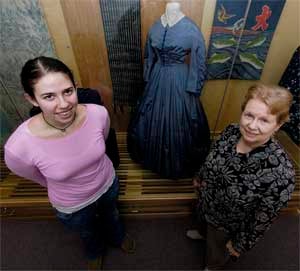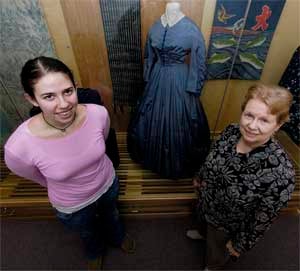 KINGSTON, R.I. — November 22, 2005 — Have you ever wondered why most historic flags are often a combination of red, white, and blue? It has to do with the use of madder and indigo: two of the world’s oldest and most long-lasting natural textile dyes. Garments dyed with madder and indigo, as well as a number of other natural dye displays are currently on exhibit in the University of Rhode Island’s Textile Gallery, located in Quinn Hall on the Kingston campus.
KINGSTON, R.I. — November 22, 2005 — Have you ever wondered why most historic flags are often a combination of red, white, and blue? It has to do with the use of madder and indigo: two of the world’s oldest and most long-lasting natural textile dyes. Garments dyed with madder and indigo, as well as a number of other natural dye displays are currently on exhibit in the University of Rhode Island’s Textile Gallery, located in Quinn Hall on the Kingston campus.
“Nature’s Dyes: Clothing and Textiles from Around the Globe,” is on exhibit through March 1, 2006. Free and open to the public, the gallery is open Monday- Friday from 8:30 a.m. to 4:30 p.m.
Textiles, Fashion Merchandising, and Design department Professor Margaret Ordoñez of Cumberland, R.I., and Samantha DeLange, a senior textiles major from Portland, Ore., curated the exhibit. They handpicked the appropriate textiles and worked with textiles graduate students to ready the fabrics for exhibition. Each textile needed to be cleaned, vacuumed, ironed, and safely mounted to the exhibition displays.
“The hardest part was mounting the pieces… we had to treat everything like it was tissue paper,” said DeLange. “It was a little stressful, but it was definitely worth it,” she said about preparing for the exhibit.
The exhibit, which is organized by color, features extensive areas devoted to madder (red), quercitron (brown), and indigo (blue). There are garments and fragments of textiles from around the world representing ancient cultures from Europe, Asia, and South America. There is also clothing on display that was worn in Rhode Island during the mid-19th century. DeLange’s favorite area of the exhibit is the indigo display. “The pieces really work well together,” she said.
Among the items on display are: a child’s red dress (ca. 1840); a red paisley shawl (ca. 1860); brown silk Swiss belts (ca. 1865); indigo trousers (ca. 1830); blue Japanese silk slippers (ca. 1820); and a blue Nigerian sling (ca. 1863).
According to the research on display with the exhibit, natural dyes, which are extracted from plants and animals, varied extensively depending on where they originated and how they were processed. This variety created a large problem with color consistency.
The materials further noted that almost all of the textile dyes used today are synthetic because they allow for more consistent color throughout the garment. The next exhibit, scheduled to open in March 2006, will focus on 150 years of synthetic dyes.
DeLange credits this experience with helping her outside the classroom. As a sales associate at Nordstrom’s in Providence, she now has a better understanding of merchandise displays. She also has more information to share with customers regarding dye care methods for their purchases. She will graduate from URI in May and later plans to pursue graduate studies in art, textile, and artifact conservation.
Ordoñez, who is also the director of URI’s Historic Textile and Costume Collection, is pleased with the exhibit and encourages visitors to view the display. “ This Gallery provides an opportunity to exhibit items from our collection that are otherwise only seen by students. It also serves as a means to share our knowledge and research about textiles with the community.”
The Textile Gallery opened in 1999 to showcase items from the program’s Historic Textile and Costume Collection. For more information about the current or past exhibits, please visit http://www.uri.edu/ hss/tmd/Gallery.htm.
Pictured above:
CURATORS OF NATURAL DYES: Samantha DeLange, a senior textiles major from Portland, Ore., and Textiles, Fashion Merchandising, and Design department professor Margaret Ordoñez stand before a case at the URI Textiles Gallery that features an 1845 Women’s silk daywear dress colored with all natural Indigo Dye. The exhibit, which runs through March 2006, is on display at the Textile Gallery, located in Quinn Hall on the Kingston campus.
URI News Bureau Photo by Michael Salerno Photography

